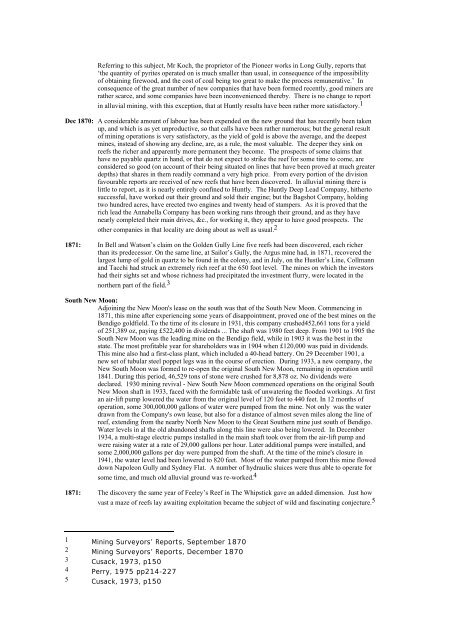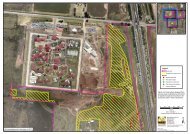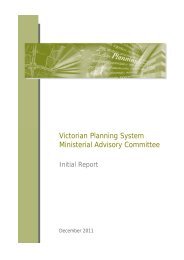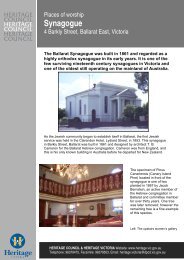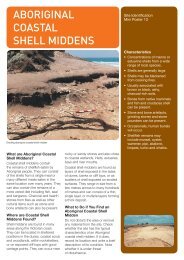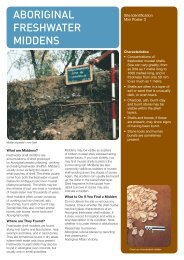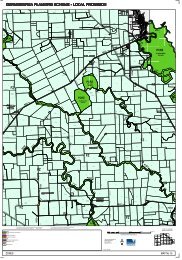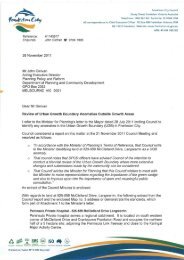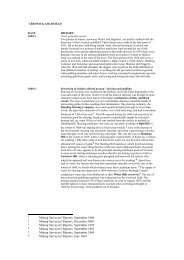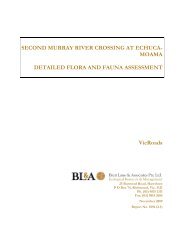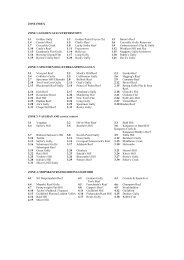Bendigo General History - Department of Planning and Community ...
Bendigo General History - Department of Planning and Community ...
Bendigo General History - Department of Planning and Community ...
You also want an ePaper? Increase the reach of your titles
YUMPU automatically turns print PDFs into web optimized ePapers that Google loves.
Referring to this subject, Mr Koch, the proprietor <strong>of</strong> the Pioneer works in Long Gully, reports that<br />
‘the quantity <strong>of</strong> pyrites operated on is much smaller than usual, in consequence <strong>of</strong> the impossibility<br />
<strong>of</strong> obtaining firewood, <strong>and</strong> the cost <strong>of</strong> coal being too great to make the process remunerative.’ In<br />
consequence <strong>of</strong> the great number <strong>of</strong> new companies that have been formed recently, good miners are<br />
rather scarce, <strong>and</strong> some companies have been inconvenienced thereby. There is no change to report<br />
in alluvial mining, with this exception, that at Huntly results have been rather more satisfactory. 1<br />
Dec 1870: A considerable amount <strong>of</strong> labour has been expended on the new ground that has recently been taken<br />
up, <strong>and</strong> which is as yet unproductive, so that calls have been rather numerous; but the general result<br />
<strong>of</strong> mining operations is very satisfactory, as the yield <strong>of</strong> gold is above the average, <strong>and</strong> the deepest<br />
mines, instead <strong>of</strong> showing any decline, are, as a rule, the most valuable. The deeper they sink on<br />
reefs the richer <strong>and</strong> apparently more permanent they become. The prospects <strong>of</strong> some claims that<br />
have no payable quartz in h<strong>and</strong>, or that do not expect to strike the reef for some time to come, are<br />
considered so good (on account <strong>of</strong> their being situated on lines that have been proved at much greater<br />
depths) that shares in them readily comm<strong>and</strong> a very high price. From every portion <strong>of</strong> the division<br />
favourable reports are received <strong>of</strong> new reefs that have been discovered. In alluvial mining there is<br />
little to report, as it is nearly entirely confined to Huntly. The Huntly Deep Lead Company, hitherto<br />
successful, have worked out their ground <strong>and</strong> sold their engine; but the Bagshot Company, holding<br />
two hundred acres, have erected two engines <strong>and</strong> twenty head <strong>of</strong> stampers. As it is proved that the<br />
rich lead the Annabella Company has been working runs through their ground, <strong>and</strong> as they have<br />
nearly completed their main drives, &c., for working it, they appear to have good prospects. The<br />
other companies in that locality are doing about as well as usual. 2<br />
1871: In Bell <strong>and</strong> Watson’s claim on the Golden Gully Line five reefs had been discovered, each richer<br />
than its predecessor. On the same line, at Sailor’s Gully, the Argus mine had, in 1871, recovered the<br />
largest lump <strong>of</strong> gold in quartz to be found in the colony, <strong>and</strong> in July, on the Hustler’s Line, Collmann<br />
<strong>and</strong> Tacchi had struck an extremely rich reef at the 650 foot level. The mines on which the investors<br />
had their sights set <strong>and</strong> whose richness had precipitated the investment flurry, were located in the<br />
northern part <strong>of</strong> the field. 3<br />
South New Moon:<br />
Adjoining the New Moon's lease on the south was that <strong>of</strong> the South New Moon. Commencing in<br />
1871, this mine after experiencing some years <strong>of</strong> disappointment, proved one <strong>of</strong> the best mines on the<br />
<strong>Bendigo</strong> goldfield. To the time <strong>of</strong> its closure in 1931, this company crushed452,661 tons for a yield<br />
<strong>of</strong> 251,389 oz, paying £522,400 in dividends ... The shaft was 1980 feet deep. From 1901 to 1905 the<br />
South New Moon was the leading mine on the <strong>Bendigo</strong> field, while in 1903 it was the best in the<br />
state. The most pr<strong>of</strong>itable year for shareholders was in 1904 when £120,000 was paid in dividends.<br />
This mine also had a first-class plant, which included a 40-head battery. On 29 December 1901, a<br />
new set <strong>of</strong> tubular steel poppet legs was in the course <strong>of</strong> erection. During 1933, a new company, the<br />
New South Moon was formed to re-open the original South New Moon, remaining in operation until<br />
1841. During this period, 46,529 tons <strong>of</strong> stone were crushed for 8,878 oz. No dividends were<br />
declared. 1930 mining revival - New South New Moon commenced operations on the original South<br />
New Moon shaft in 1933, faced with the formidable task <strong>of</strong> unwatering the flooded workings. At first<br />
an air-lift pump lowered the water from the original level <strong>of</strong> 120 feet to 440 feet. In 12 months <strong>of</strong><br />
operation, some 300,000,000 gallons <strong>of</strong> water were pumped from the mine. Not only was the water<br />
drawn from the Company's own lease, but also for a distance <strong>of</strong> almost seven miles along the line <strong>of</strong><br />
reef, extending from the nearby North New Moon to the Great Southern mine just south <strong>of</strong> <strong>Bendigo</strong>.<br />
Water levels in al the old ab<strong>and</strong>oned shafts along this line were also being lowered. In December<br />
1934, a multi-stage electric pumps installed in the main shaft took over from the air-lift pump <strong>and</strong><br />
were raising water at a rate <strong>of</strong> 29,000 gallons per hour. Later additional pumps were installed, <strong>and</strong><br />
some 2,000,000 gallons per day were pumped from the shaft. At the time <strong>of</strong> the mine's closure in<br />
1941, the water level had been lowered to 820 feet. Most <strong>of</strong> the water pumped from this mine flowed<br />
down Napoleon Gully <strong>and</strong> Sydney Flat. A number <strong>of</strong> hydraulic sluices were thus able to operate for<br />
some time, <strong>and</strong> much old alluvial ground was re-worked. 4<br />
1871: The discovery the same year <strong>of</strong> Feeley’s Reef in The Whipstick gave an added dimension. Just how<br />
vast a maze <strong>of</strong> reefs lay awaiting exploitation became the subject <strong>of</strong> wild <strong>and</strong> fascinating conjecture. 5<br />
1 Mining Surveyors’ Reports, September 1870<br />
2 Mining Surveyors’ Reports, December 1870<br />
3 Cusack, 1973, p150<br />
4 Perry, 1975 pp214-227<br />
5 Cusack, 1973, p150


